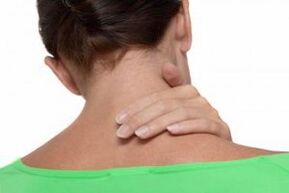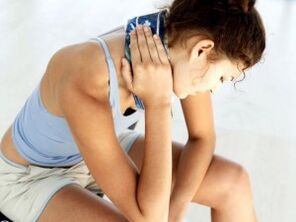Cervical osteochondrosis is common, accompanied by pain in the head, neck, shoulder girdle, and cerebral circulation disorders. The peculiarities and contradictory manifestations of the localization of the pathological process force patients to turn to specialists. Lack of timely treatment can lead to disability.
Typically, cervical osteochondrosis affects young adults (up to 40 years old), resulting in incorrect body posture (the habit of sitting in front of a computer for long periods of time, holding a phone over your shoulder), vibration, poor posture, lack of exercise, uncomfortable bedding, hereditary.
possible reason
The disease is accompanied by degenerative dystrophic changes affecting the cervical discs. This is caused by metabolic disturbances in the neck area, so the structure of the disc and its body changes.
The main cause of the disease:
- High levels of salt in lymph and blood (in active people there is a constant exchange between bone and muscle tissue, in a static lifestyle, blood flow slows and less salt enters muscle tissue, which can accumulate inbody of action - joints, spine, kidneys, liver);
- irreversible phenomena that occur in cartilage tissue (salt deposition leads to changes in shock-absorbing properties in the vertebrae, loss of flexibility and elasticity of cartilage tissue);
- prolonged stay in positions that cause overuse of the neck muscles, the back (twisting the neck and tilting the head when working on a table), squeezing the blood vessels supplying the spine, causing degeneration of the intervertebral cartilage;
- With obesity, the spine and discs are deformed by high loads, and the back muscles corset weaken;
- Due to improper metabolism, the balance of minerals in bone tissue is disturbed.
characteristic symptoms

The main manifestations of cervical osteochondrosis:
- pain in the back of the head, neck, shoulders, arms, difficulty moving the head, creaking when turning the head or tilting;
- Pain of a pulling nature in the left chest area, irradiated left hand, and burning sensation in the interscapular area;
- Repeated headaches, fatigue, weakness, difficulty turning your head;
- Neck pain passing to the shoulders and arms, numbness in the fingers;
- Hearing and vision loss, tongue and face numbness, dizziness, and impaired lung and heart activity may occur.
Traditionally, symptoms are divided into groups:
- I - neurological manifestations (persistent pain in the neck, pain in the muscles, chest, joints);
- II - pathological effects on the spinal cord (weakness of the arms and legs, involuntary twitching, myelopathy);
- III - related to processes occurring in the brain (cerebral manifestations due to insufficient blood supply: visual disturbances, foreign body sensation in the throat, noise and tinnitus, hearing loss, dizziness, unsteady walking, fainting, fatigue, irritability, sleep disturbance, memory loss).
General advice
In the absence of an indication for hospitalization, outpatient treatment was prescribed (patients were at home most of the time, visiting a neurologist on designated days). Medications used:
- NSAIDs course 7 - 14 days (2 - 3 times a day);
- Sedatives to protect the nervous system from pain for 1-3 weeks;
- Diuretics to reduce swelling in inflamed areas;
- B vitamins improve metabolic processes taking place in nervous tissue, normalize musculoskeletal conduction;
- muscle relaxants to relieve muscle spasms;
- Means to improve the structure and function of cartilage tissue (ATP, chondroprotective agent);
- Topical - creams, gels, ointments as warmth, pain relief or distraction.
As pain intensifies, bed rest is recommended, in a physiological position (to reduce the load on the spine) for 1-2 days, after which the patient should start moving.
During the acute phase, breathing exercises and exercises to relieve muscle spasms (smooth head tilt and rotation, circular movements) are required, gradually increasing the load. You should not make sudden movements.
For muscle spasms, prescribe massage (you can do a self-massage of the neck). As a precaution, massage should be done twice a year. To unload the spine, use a cervical collar or Glisson ring (after consulting your doctor beforehand).
Nutrition should be adjusted by excluding foods that increase muscle tone (smoky and spicy, alcohol, coffee, tea). Useful for cartilage tissue:

- foods high in calcium (fermented milk, cottage cheese, mineral water, dark green leafy vegetables);
- Unsaturated fatty acids (fatty fish, flaxseed, nuts);
- protein (lean poultry, dairy, eggs, nuts);
- Foods rich in fiber and antioxidants (beans, grains, fruits).
In the absence of deterioration, it is recommended to drink enough water (30 ml per 1 kg of body weight) and strengthen the spine and back muscles through physical exercise. When sitting for long periods of time, take breaks every hour to relax your back muscles with exercises.
How to treat folk remedies?
For cervical osteochondrosis, herbal infusions or decoctions are recommended, and ointments are applied to the problem area.
| Element | quantity | How to apply |
|---|---|---|
| pine needles | 250 g | Insist on brewing the needle with a liter of boiling water. Drink twice a day. |
| garlic, ginger | 1: 1 | Add grated ginger to garlic, a little butter. Rub on sore neck areas. |
| lemon, garlic | 4 things. and 5. | Pass the lemon and garlic through a meat grinder and pour in 2 liters of boiling water. Drink ½ cup twice a day. |
| fresh potatoes, honey | 1: 1 | Mix grated potato porridge with honey and apply to neck. |
| horseradish leaves | 1. | Dip the horseradish leaves in boiling water for a few seconds, then remove. Cooling liquid for compression. |
| horseradish | 2 teaspoons | The ground horseradish root is tied to a bandage, attached to the neck, covered with plastic wrap and wrapped. Leave on for 1 - 1. 5 minutes, then rinse with water. |
| Honey | 1 dessert scoop | Warm up the neck and perform a 5-minute self-massage with honey. After that, wrap around your neck. |
What not to recommend?
With cervical osteochondrosis, you cannot:
- Lift weights (if necessary, with your back straight and your head not tilted forward);
- You cannot squeeze the vertebrae (these movements violate the integrity of the spine's contact surface);
- sleeping on high pillows, soft beds (causing back muscle tension);
- Live a sedentary lifestyle (jogging, swimming, walking are useful);
- Independent diagnosis and treatment.
Precaution

To prevent cervical osteochondrosis, it is recommended to:
- Get rid of fatigue (exercise more, participate in Nordic walking, dancing, swimming);
- Monitor body weight to avoid excess weight (which leads to impaired circulation and malnutrition in the collar area);
- Monitoring posture (if violated, uneven distribution of load on the spine);
- Prevention of microtrauma in the neck area (proper weight lifting and wearing);
- Treats foci of chronic infections (ear, nose and throat organs, etc. ), which reduce the body's resistance, lymphatic and blood circulation in the ligaments and tissues of the neck.
Comprehensive treatment can achieve a good therapeutic effect of cervical osteochondrosis. Treatment at home will only be effective if all prescriptions and their daily use are carefully followed.



















